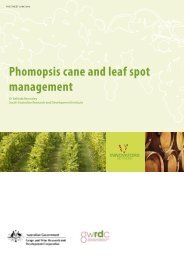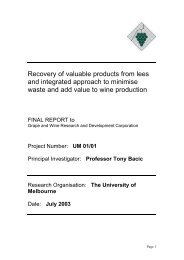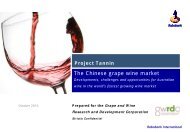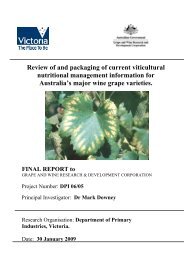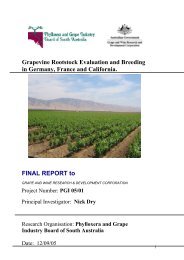Identification of the major drivers of 'phenolic' taste in ... - GWRDC
Identification of the major drivers of 'phenolic' taste in ... - GWRDC
Identification of the major drivers of 'phenolic' taste in ... - GWRDC
Create successful ePaper yourself
Turn your PDF publications into a flip-book with our unique Google optimized e-Paper software.
AWRI: <strong>Identification</strong> Of The Major Drivers Of ‘Phenolic’ Taste In White W<strong>in</strong>es<br />
1.1.1 Hydroxyc<strong>in</strong>namates<br />
The <strong>major</strong> non-flavonoids <strong>in</strong> white w<strong>in</strong>e are <strong>the</strong> hydroxybenzoic and hydroxyc<strong>in</strong>namic acids.<br />
Hydroxyc<strong>in</strong>namic acids (HCA’s) and <strong>the</strong>ir derivatives, collectively referred to as hydroxyc<strong>in</strong>namates,<br />
are <strong>the</strong> most abundant phenolic compounds <strong>in</strong> white w<strong>in</strong>es. The hydroxyc<strong>in</strong>namic acids present <strong>in</strong><br />
w<strong>in</strong>e are ma<strong>in</strong>ly derived from caffeic, p-coumaric, ferulic, and s<strong>in</strong>apic acids. While <strong>the</strong>y can be present<br />
<strong>in</strong> both cis- and trans forms, <strong>the</strong> trans form is more prevalent. The concentrations <strong>of</strong> HCA <strong>in</strong> <strong>the</strong>ir free<br />
form are low <strong>in</strong> comparison to <strong>the</strong>ir esters <strong>of</strong> l-(+)-tartaric acid – <strong>the</strong> most important be<strong>in</strong>g <strong>the</strong> ester <strong>of</strong><br />
caffeic acid known as caftaric acid. (Ong and Nagel 1978; S<strong>in</strong>gleton et al. 1978; Somers et al. 1987).<br />
Caftaric acid is <strong>the</strong> most abundant hydroxyc<strong>in</strong>namate <strong>in</strong> both juice and w<strong>in</strong>e, but <strong>the</strong> tartaric esters <strong>of</strong><br />
p-coumaric acid and ferulic acid are also present (Somers and Ziemelis 1985; Vérette and Somers<br />
1988; Cro<strong>the</strong>rs 2005).<br />
An important derivative <strong>of</strong> caftaric acid that has significant w<strong>in</strong>emak<strong>in</strong>g implications is 2-S-<br />
glutathionyl caftaric acid, better known as Grape Reaction Product (GRP). It forms when polyphenol<br />
oxidase (PPO) enzymes oxidise caftaric acid to <strong>the</strong> qu<strong>in</strong>one which <strong>the</strong>n chemically (i.e. non-<br />
enzymatically) react with <strong>the</strong> grape peptide glutathione. Similar GRP-like conjugates <strong>in</strong>volv<strong>in</strong>g o<strong>the</strong>r<br />
hydroxyc<strong>in</strong>namic acids and peptides <strong>in</strong>clud<strong>in</strong>g cyste<strong>in</strong>e and glutam<strong>in</strong>e are also formed by <strong>the</strong> same<br />
mechanism. However, <strong>the</strong>se are far less abundant than glutathionyl caftaric acid.<br />
Numerous o<strong>the</strong>r derivatives <strong>of</strong> HCAs have been found <strong>in</strong> white w<strong>in</strong>e. These are <strong>the</strong> ethyl esters <strong>of</strong><br />
caffeic acid and coumaric acid, <strong>the</strong> ethyl esters and diethyl esters <strong>of</strong> caftaric acid and <strong>the</strong> glucosides <strong>of</strong><br />
all <strong>the</strong> <strong>major</strong> free hydroxyc<strong>in</strong>namic acids (Baderschneider and W<strong>in</strong>terhalter 2001; Somers et al. 1987;<br />
Monagas et al. 2005).<br />
The most prevalent benzoic acids <strong>in</strong> white w<strong>in</strong>e are gallic acid, gentisic acid, p-hydroxybenzoic acid,<br />
protocatechuic acid, syr<strong>in</strong>gic acid and salicylic acid. Unlike <strong>the</strong> hydroxyc<strong>in</strong>nnamic acids, <strong>the</strong>y are<br />
usually found <strong>in</strong> <strong>the</strong>ir free form, and <strong>in</strong> comparatively low concentrations (Baderschneider and<br />
W<strong>in</strong>terhalter 2001). Of <strong>the</strong>se gallic acid is <strong>the</strong> most abundant. While it is found <strong>in</strong> <strong>the</strong> grape itself, it<br />
also is released follow<strong>in</strong>g <strong>the</strong> hydrolysis <strong>of</strong> <strong>the</strong> gallic acid esters <strong>of</strong> flavan-3-ols. Ethyl and methyl<br />
esters <strong>of</strong> vanillic and protocatechuic acids, and <strong>the</strong> glucose ester <strong>of</strong> vanillic acid have also been<br />
isolated from white w<strong>in</strong>es.<br />
Hydroxyc<strong>in</strong>namic acids, benzoic acids and <strong>the</strong>ir derivatives are mostly found <strong>in</strong> <strong>the</strong> pulp <strong>of</strong> white<br />
grapes with up to 200 mg/L be<strong>in</strong>g reported <strong>in</strong> free run juice (Ong and Nagel 1978). White sk<strong>in</strong>s have<br />
also been reported to conta<strong>in</strong> up to 45 mg/kg <strong>of</strong> hydroxyc<strong>in</strong>namates (Rodriguez Montealegre et al.<br />
2006). Given that white w<strong>in</strong>es are primarily made from <strong>the</strong> pulp <strong>of</strong> grapes, it is not surpris<strong>in</strong>g that <strong>the</strong><br />
comb<strong>in</strong>ed level <strong>of</strong> hydroxyc<strong>in</strong>namates can be substantial relative to o<strong>the</strong>r phenolic compounds found<br />
<strong>in</strong> white w<strong>in</strong>e. As an example, a survey <strong>of</strong> 26 Greek white w<strong>in</strong>es found an average hydroxyc<strong>in</strong>namate<br />
level six times higher than <strong>the</strong> comb<strong>in</strong>ed concentration <strong>of</strong> <strong>the</strong> o<strong>the</strong>r phenolics present (Makris et al.<br />
2003). Similarly, <strong>the</strong> comb<strong>in</strong>ed concentration <strong>of</strong> caffeic and coumaric acids <strong>in</strong> dry Muscat w<strong>in</strong>es was<br />
found by (Karagiannis et al. 2000) to be between 6 and 16 times higher than <strong>the</strong> comb<strong>in</strong>ed<br />
concentrations <strong>of</strong> <strong>the</strong> important flavan-3-ol monomers, catech<strong>in</strong> and epicatech<strong>in</strong>.<br />
Page | 11




